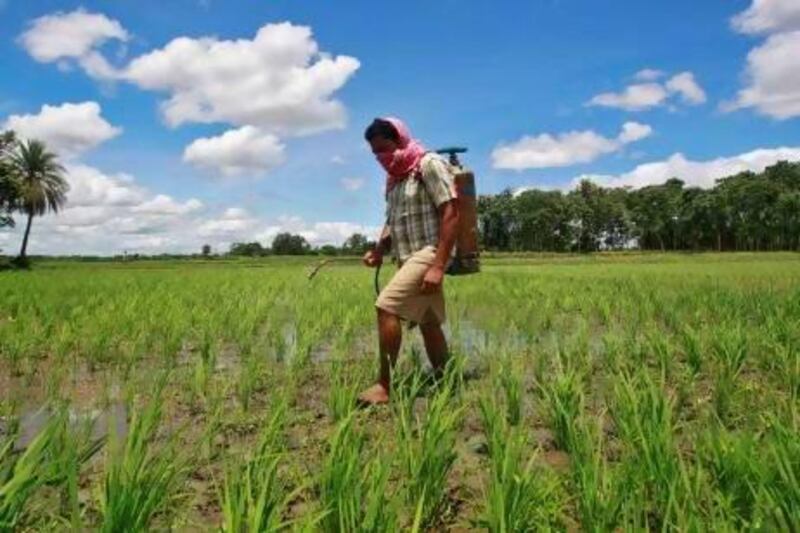MUMBAI // Nearly a decade ago, the Indian government ruled out a ban on the production and use of monocrotophos, the highly toxic pesticide that killed 23 children this month in a village school providing free lunches under a government-sponsored programme.
Despite its being labelled highly hazardous by the World Health Organisation, a panel of government experts was persuaded by manufacturers that monocrotophos was cheaper than alternatives and more effective in controlling pests that decimate crop output.
India, which has more hungry mouths to feed than any other country in the world, continues to use monocrotophos and other highly toxic pesticides that rich and poor nations alike, including China, are banning on health grounds.
Although the government argues the benefits of strong pesticides outweigh the hazards if properly managed, the school food poisoning tragedy underlined criticism that such controls are virtually ignored on the ground.
According to the minutes, the 2004 meeting of the Central Insecticides Board and Registration Committee - the Indian government body that regulates pesticide use - concluded that: "The data submitted by the industry satisfies the concerns raised ... Therefore, there is no need to recommend the ban of this product."
Government scientists continue to defend the pesticide and insist the decision to not ban it remains good.
According to records on the agricultural meteorology division's website, just weeks before the school tragedy in Bihar state, the Indian government advised farmers via text message to use monocrotophos to kill borer pests in mandarin fruits and rice.
"It is cost effective and it is known for its efficacy ... some even call it a benevolent pesticide," said TP Rajendran, the assistant director general for plant protection at the Indian Council of Agricultural Research.
"I can say that pesticides currently permitted in the country are safe provided they are used as per specifications and guidelines. We have exhaustive and detailed guidelines. They need to be followed."
A senior official directly involved in the decision-making on pesticide use said: "You have got to understand that all pesticides are toxic but they are essential for maintaining or increasing agricultural production.
"Can we afford to lose 15 per cent to 25 per cent of output? One cannot afford to lose such a large percentage of agricultural produce. The answer lies in judicious use."
The official declined to be identified.
The WHO has cited a 2007 study that about 76,000 people die each year in India from pesticide poisoning. Many of the deaths are suicides made easy by the wide availability of toxic pesticides.
In the school tragedy, police suspect the children's lunch was cooked in oil that had been stored in a container originally used for monocrotophos.
The Indian government has issued 15 pages of regulations that need to be followed when handling pesticides, including wearing protective clothing and using a respirator when spraying. Pesticide containers should be broken when empty and not left outside to prevent them being reused.
But in a nation where a quarter of the 1.2 billion population is illiterate and vast numbers live in far-flung rural districts, implementation is almost impossible. For instance, monocrotophos is banned for use on vegetable crops, but there is no way to ensure the rule is followed.
According to the WHO, swallowing 1,200 milligrams - less than a teaspoon - of monocrotophos can be fatal to humans. In 2009, it called for India to ban the product because of its extreme toxicity.
"It is imperative to consider banning the use of monocrotophos," it said in a 60-page report. "The perception that monocrotophos is cheap and necessary, have prevented the product from being taken off the market" in India.
WHO officials say the school tragedy reinforces the dangers of the pesticide.
"We would advocate that countries restrict, ban, or phase out ... those chemicals for which they can't ensure that all aspects of use are safe," said Lesley Onyon, WHO's South-east Asia regional adviser for chemical safety. "If they can't ensure safety, it's our policy to say that these chemical or pesticides shouldn't be used."
Indian government officials refuse to address the WHO's findings directly.
"We have to take decisions depending on our need, our priorities, and our requirements. No one knows these things better than us," said the government source.
For India, providing more food to its people is a national priority. According to the World Bank, nearly 400 million people in the country live on less than US$1.25 (Dh4.60) per day.
Nearly half its children under five are malnourished.
The Bihar school where the children died was participating in the government's midday meal programme, aimed at giving 120 million school pupils a free lunch - both providing nutrition and encouraging education.
India is also close to implementing an ambitious plan to provide cheap food to 800 million people.
Central to these efforts will be higher crop yields and managing costs.
According to government officials and manufacturers, monocrotophos is cheap and is also a broad spectrum pesticide that can only be replaced by four or five crop- or pest-specific pesticides. Even similar pesticides are much more expensive.
A 500 ml monocrotophos bottle sold by Godrej Agrovet, a subsidiary of Godrej Industries, is priced at 225 rupees (Dh14), while an alternative, Imidacloprid, in a bottle of 500ml produced by Bayer, costs 1,271 rupees.
Monocrotophos is banned by many countries, including the United States, the European Union nations and China and, among India's neighbours, Pakistan.
Sri Lanka only allows monocrotophos use for coconut cultivation.
One of the two companies that argued against the ban on monocrotophos in 2004 halted production five years later under pressure from the public in its home country, Denmark.
Cheminova, a unit of Auriga Industries, said it stopped producing monocrotophos in India in 2009 and converted its plant to produce a low-toxic fungicide.
"We decided to phase out monocrotophos because with many alternative products, we could not see any reason to have such a toxic product in a country like India," said Lars-Erik Pedersen, the vice-president of Auriga Industries.
"It was a big decision because it is one of the best-selling products in India."
The other manufacturer that made a presentation at the 2004 meeting was United Phosphorus, the biggest producer of the pesticide in the country.
The managing director, Rajju D Shroff, said that monocrotophos was "very harmless" and hinted that calls for a ban were aimed at helping multinationals sell more costly alternatives.
"Companies want to sell new pesticides. If they have monocrotophos, farmers will not change to new, expensive ones," said Mr Shroff, who attended the meeting as the head of the Crop Care Federation of India, a position he still holds.
Historically, India appears reluctant to ban pesticides. Monocrotophos isn't the most toxic pesticide used in the country, according to the WHO's classifications. Phorate, methyl parathion, bromadiolone and phosphamidon, all classified as extremely hazardous, are likewise registered for use.
Endosulfan - a substance so nasty the United Nations wants it eliminated worldwide - was banned only by a Supreme Court order in 2011. The decision came a few months after the chief minister of the southern state of Kerala, the top elected official, went on a day-long hunger fast to demand the ban.
According to media reports, more than 1,000 people were killed and hundreds born deformed because of indiscriminate aerial spraying of endosulfan in Kasargod, a Kerala district.
Both production of monocrotophos and demand in India was higher in 2009/10 than in 2005/06, according to latest available government data. It accounted for about 4 per cent of total pesticide use in 2009/10 and 7 per cent of production.Its share in total sales is about 2-3 per cent now, according to the Pesticides Manufacturers & Formulators Association, which says it represents the industry on a national basis with more than 250 members.
The Centre for Science and Environment, a leading environmental NGO in India, says the state of pesticide control in the country is deplorable and companies have great influence.
"The story on the ground is abysmal, it's very disappointing," said Amit Khurana, programme manager in the CSE's food safety and toxins unit.
"People still do not know how much of pesticide is to be used, which pesticide is to be used for which crop. The biggest influence for a farmer is the sales representative of the company ... so there's this sense of gross mismanagement at that level."
The government has tried to introduce legislation for "more effective regulation of import, manufacture, export, sale, transport, distribution and use of pesticides" but the bill has languished in parliament since 2008.
India is no stranger to the dangers of pesticides. Besides the thousands killed each year, the country was the location for the world's worst industrial disaster when lethal methyl isocyanate gas leaked from a pesticide plant in the city of Bhopal in 1984, killing nearly 4,500 people.
But in the fields of rural India, pesticides like monocrotophos continue to be widely used.
"I have been using it for the last 10 years, I have a very good experience," said Gaiyabhu Patil, a 56-year-old farmer who has just finished spraying monocrotophos on his 15-acre cotton crop in the western state of Maharashtra. "It is cheap and effective."
Anil Dhole, a pesticide trader in Koregaon, a district town south-east of Mumbai at the centre of a sugarcane and cotton-growing region, said few of his customers took health warnings seriously.
"Many farmers don't take the necessary precautions while applying the pesticide," he said.
"We do inform them about its toxic nature, but they take it casually. Farmers don't even bother to cover their noses."





